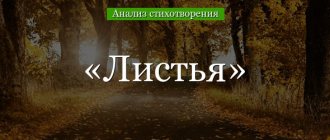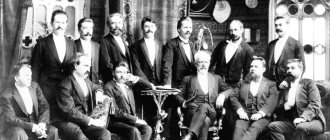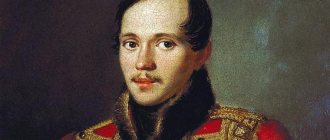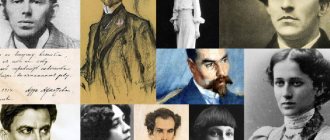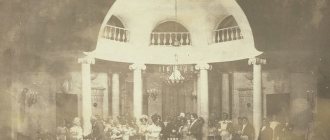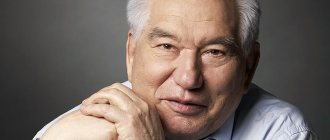When studying the work of a writer, poet, or prose writer, a mandatory requirement is to study his biography. The biography will tell us about a person’s life, tell us about what period of time the famous writer was born, how difficult and thorny his creative path was, tell us when the author first put his thoughts on paper, writing his first masterpiece. Did his thoughts come easily to him? Did anyone hinder his creativity? A short biography will tell you about this and much more.
Brief biography of personal life
Of course, in the school curriculum it is more important to become familiar with the work, but at the same time, a biography is also needed. Ask: “What does information provide about the creator’s life?” We will answer: “When you know the biography of a writer’s life and creative path, you begin to understand why he wrote this particular work.” It is necessary to study the biography of a writer’s personal life at least in order to understand his work, to understand what living conditions, what changes, what political and government events influenced the creation of the writer’s next creation. When you know a short biography of the creator, his work is perceived differently, you begin to understand it more deeply, more meaningfully, and look at many things in the text of the work in a new way. In this regard, it is simply necessary to get acquainted with the history of a person’s life before studying his work.
And in order not to go far, here you will find biographies and biographies of all the authors of the works that are included in the school curriculum.
Ilya Repin: biography and creativity
Published: 11/01/2019
When depicting a person, the artist tried to convey not only his appearance, but also his mood and character. The historical characters on the canvases of Ilya Repin looked incredibly alive and modern. The key figure of Russian realism - Repin in his biography wrote many portraits of famous people, historical subjects and paintings on ordinary everyday topics. Repin short biography Small homeland of the future world famous [...]
no comments yet
Brief biography of Dostoevsky F. M. - the most important and important
Born on November 11, 1821 in Moscow. Father - Mikhail Andreevich Dostoevsky, doctor. Mother - Maria Fedorovna. In 1898 he graduated from the Vvedensky gymnasium. In 1837 he moved to St. Petersburg. In 1843 he graduated from the Main Engineering School. In 1849, he was sentenced to death in the case of the Petrashevites, but later it was replaced by four years of hard labor. In 1857 he married Maria Isaeva. In 1867 he married Anna Snitkina, with whom he had 4 children. Died February 9, 1881, aged 59. He was buried at the Tikhvin Cemetery in St. Petersburg. Main works: “Crime and Punishment”, “Demons”, “Idiot”, “The Brothers Karamazov”, “The Gambler” and others.
Joseph Brodsky: biography and creativity
Published: 10/31/2019
Brodsky wrote about what he felt; his statements often ran counter to party policy and exposed the shortcomings of the Soviet system. His biography is replete with extraordinary events and unexpected turns of fate. Brodsky, short biography Joseph was born on May 24, 1940 in one of the maternity hospitals of pre-war Leningrad. A joyful event occurred in the family of photojournalist Alexander Ivanovich Brodsky and […]
no comments yet
Service and exile to the Caucasus
In 1834, Lermontov was sent as an officer to the Guards Hussar Regiment stationed in Tsarskoye Selo. But Misha went there only for duty and parades, spending most of his time in St. Petersburg.
After Lermontov learned about Pushkin’s death, he was very upset by this event and even wrote the poem “The Death of a Poet.” It was because of him that he was exiled to the Caucasus. In his work, as it seemed to the authorities, he expressed contempt and a careless attitude towards Emperor Nicholas 1. Initially, this poem was not written for the public, but despite this, it quickly spread among creative youth. Thus, the verse became popular, and its content could not be hidden from the emperor.
During his service, Mikhail visited many places in Transcaucasia and lived in Tiflis. He really liked the nature of this region, and it gave him the idea for writing the poems “Mtsyri” and “Demon”.
Thanks to his grandmother’s request, Lermontov was reinstated to the rank of cornet in the Life Guards Hussar Regiment, after which he returned to St. Petersburg. Soon after his return, he quarreled with the son of the French ambassador, Ernest Barant, and fought a duel with him. And again the anger of Nicholas 1 fell on Lermontov while the second duelist remained unnoticed.
The angry emperor again sent the poet into exile to the Caucasus, not sparing him. In this exile, Lermontov took part in hostilities on the front line, and even received a real baptism of fire, which subsequently affected his work.
In 1841 he returned to St. Petersburg, having served his full sentence. Lermontov had the right to resign, which is what he wanted to do. But his grandmother, whose orders he followed unconditionally, was against such a decision. He could not resist her will, because the woman had a huge influence on the boy. She did not like the fact that Mikhail was engaged in poetry, and she forced him to continue his military career.
In 1841, Lermontov left for the Tenginsky infantry regiment. The disappointments and trials he experienced made the young poet a bitter and caustic person, even towards people close to him. He began to often bully Martynov, which led to his final outcome.
Byron biography
Published: 10/04/2019
“Gloomy egoism” was characteristic of the literary works of the classic of English poetry. The plots of Byron's works often repeated the events of his biography, so one of the characters, Childe Harold, is considered to be the author's alter ego. Byron short biography George Gordon Byron was born on January 22, 1788 in the capital of England. The biography reports that his father was a bankrupt aristocrat, the son of an admiral. Marriage to Katherine […]
no comments yet
Goethe biography: creativity, personal life, interesting facts
Published: 10/01/2019
The playwright, poet and writer, thanks to his inimitable talent, entered the history of world literature. The German writer Goethe, as his biography reports, was a versatile, enthusiastic person, he had an insatiable interest in life. Johann Goethe short biography The German trading town of Frankfurt am Main gained even greater fame in the world due to the fact that on August 28, 1749 […]
no comments yet
Abstracts on biography
An abstract on a biography is a report on a specific topic, including a review of relevant literary and other sources and a brief summary of the content of the “Biography”, book (or part thereof), article with basic factual information and conclusions.
The volume of the biography abstract ranges from 16 to 23 pages.
Completing a biography essay includes:
- choosing a topic;
- selection and analysis of literature, various views and concepts on this issue set out in it, if necessary - analysis of the practical situation based on its theoretical aspects;
- drawing up a work plan for the essay, coordinating it with the teacher leading the seminar (practical) classes;
- writing an abstract;
- preparation of the abstract.
If you want to learn how to write an essay on any subject yourself, then on the page “what is an essay and how to write it” I explained in detail.
Structure of a biography essay
The biography abstract must contain the following structural elements:
- title page;
- content;
- introduction;
- main text;
- conclusion;
- bibliography.
- applications.
Title page
The title page is the initial page of the essay and serves as a source of information for the teacher.
The title page contains:
- The full name of the educational institution is indicated at the top.
- The middle field indicates the type of work and academic subject (biography abstract).
- Below in the center of the heading is the name of the topic of the abstract.
- Even lower, closer to the right edge of the title page, the student’s full name and group are indicated. Even lower is the full name and position of the teacher.
- The lower field indicates the city and year the abstract was completed (without the word “year”).
Example:
Content
Contents is a mandatory element of the apparatus, serving for orientation in the abstract and indicating headings.
The table of contents includes all structural elements of the abstract, including serial numbers and names of all structural units of the main text, indicating the page numbers on which they begin.
The contents are placed on the page of the abstract following the title page, included in the total number of pages of the abstract, but not numbered. The title “Contents” is written in bold font, size 16, with the first capital letter, located in the center of the page margin. The names included in the table of contents are written in lowercase letters, starting with capital letters (GOST 2.105–95).
Example:
Introduction
Introduction is a structural part of the abstract, introducing the reader to the essence of the problems of its main text. The volume of the Introduction should be no more than 1 page of printed text.
The introduction is placed on a separate page, placing the word “Introduction” in the middle of the page margin, and written in bold font, size 16, with the first capital letter.
In the Introduction, the author should briefly justify the relevance
the problem (issue) covered in the abstract, justify the reasons for choosing the topic, formulate the purpose of the abstract, and present its information base.
The relevance of the study should reflect the degree of its importance at the moment for theory and practice.
The goal is the result that the author must obtain. In its formulation, it is recommended to use the following words: “identify”, “define”, “justify”, “analyze and generalize experience”, “reveal”, “consider”, etc.
The information base for the study can be materials from the federal and territorial state statistics bodies of the Russian Federation, data from primary accounting and annual reports of enterprises, normative and reference materials, materials from surveys, observations, results of an expert survey, information resources of Internet portals, etc.
Example:
Main part
The main text of the abstract should reflect the essence of the issue and contain its detailed presentation. The volume of the main text is 10-15 pages (without Introduction and Conclusion). The structure of the main text of the abstract is determined by the topic, as well as the requirements of the department.
The materials of the main text are grouped into relatively complete large problem-thematic structural units: chapters.
A chapter is a large section with an independent heading. Chapters can be divided into paragraphs.
All structural units of the main text should be numbered in Arabic numerals. Structural units must have sequential numbering throughout the entire text. For example: Chapter 1, Chapter 2 (it is allowed to limit the text to indicating only the number without using the word “Chapter”).
There is no dot at the end of the number of the structural unit of the text (GOST 2.105–95). The chapter begins on a new leaf.
In addition to structural units, other elements can be used in the main text: headings, listings, tables, figures, formulas (mathematical equations), bibliographical references, abbreviations.
Example:
Conclusion
Conclusion is the structural part of the abstract, completing it, where generalizations, conclusions, etc. are made. The main conclusions of the abstract should be formulated in short, clear sentences and statements. The volume of the Conclusion is 1-2 paragraphs (1/2 page).
The conclusion is placed on a separate page, placing the word “Conclusion” in the middle of the page margin, and written in bold font, size 16, with the first capital letter.
Example:
Bibliography
The bibliography should contain information about the sources used in writing the abstract: cited, mentioned, etc.
The bibliographic list must meet the following requirements:
- correspond to the topic of the abstract;
- include various types of publications: official, regulatory, reference, scientific, educational, etc.
Information about sources is provided in accordance with the requirements of GOST 7.1–2003 “Bibliographic record. Bibliographic description. General requirements and rules for drafting”, introduced on July 1, 2004.
A bibliographic description is a list of information about each source compiled according to certain rules. This information when describing the book includes:
- surname and initials of the author (authors);
- title;
- type of literary source (textbook, study guide, monograph);
- place of publication, publisher, year of publication;
- number of pages.
Example:
Applications
The appendices offer additional or supporting materials if they are needed in the abstract. The appendices are designed as a continuation of the abstract on its subsequent pages and are arranged in the order of appearance of links in the text. Each application should begin on a new page with the word “APPENDIX” in the center. Each application must have its own title reflecting its content. Applications are numbered sequentially in capital letters of the Russian alphabet, starting with A, with the exception of the letters E, Z, J, O, CH, Ъ, ы, ь.
Example:
How to write a biography essay
An abstract is not a simple description of facts and phenomena of history, much less a repetition of the text of textbook chapters or monographs. While working on an essay, the student must show how much he can critically analyze the collected historical material, think independently and cogently present his understanding and interpretation of the issue being studied.
A biography abstract must have the following properties:
- integrity (content-thematic, stylistic, linguistic),
- coherence (logical and formal linguistic),
- structure (presence of introduction, main part and conclusion, their optimal ratio),
- completeness (semantic and genre-compositional).
Stages of writing a biography essay:
Stage 1 - preparatory.
- searching for materials on a specific topic
- selection of literature in a specific library
- determining the range of reference materials for subsequent work on the topic.
Stage 2 - performing.
- reading books (other sources)
- keeping records of what you read (scanning)
- selection of materials
- drafting an essay plan
Stage 3 is the final stage.
- processing available materials and writing an abstract
- compiling a list of used literature.
An abstract in any form is associated with information retrieval. Only an in-depth study of the literature on the topic will provide information about the current state of the problem being studied.
For this purpose, there are libraries and thematic catalogs in the reference and bibliographic departments of libraries. Information about literature can also be gleaned from publications devoted to the chosen topic.
When working with the literature, it should be remembered that monographs, textbooks and teaching aids published this year published the results of research two years ago or more. The most relevant and “fresh” information can be obtained from scientific journals and newspapers, information materials, statistical collections, etc.
New computer technologies allow the modern researcher to work with a large amount of information. On the global network today you can find digitized works of domestic and foreign historians, electronic copies of archival documents, thousands of scanned historical sources, materials from archaeological and ethnographic expeditions, collections of photographs, maps, diagrams.
The material obtained as a result of working with literature and sources, as a rule, exceeds the required number of pages of the abstract. In the future, it will be necessary to concentrate on the selected problems, weed out unnecessary ones and write the final version of the abstract from the received material.
Once the materials needed for the paper have been selected, a sequence of research should be outlined to better determine the approximate content and appropriate structure of the abstract. When working with sources and literature, it is recommended to write down the main provisions, examples and conclusions of the studied works on separate cards or in a special notebook, accurately indicating their authors, titles and pages. It should be noted that if there are doubts about the authorship of the abstract, the teacher has the right to demand the originals of these preparatory materials.
The outline is the content of the abstract, which contains all the headings of the abstract. It should be remembered that all content headings must exactly repeat the headings in the text. A correctly drawn up outline of the essay serves as an organizational beginning of the work, helps to systematize the material and ensures consistency in its presentation. It is usually compiled on a chronological or issue basis. The first involves considering a phenomenon in its historical development (from past to present), the second involves considering several phenomena (problems) and the connections between them. You can combine both approaches using the problematic and chronological principles.
Writing an introduction for a biography essay is a very important part of the job. The introduction substantiates the relevance of the chosen topic and why it attracted attention. Reasons are given why it is of scientific interest and why it attracted the attention of researchers. It is also important to indicate how this topic is viewed by various scientific schools or individual historians. The introduction should contain a brief description of historical sources and scientific literature, as well as a historical and graphic overview of the problem. Then the purpose and content of the essay task are determined. At the end of the introduction, it is advisable to reveal the structure of the abstract, as well as give a list of its structural elements and justify the sequence of their arrangement. The introduction is two or three pages long.
Writing the text of the main part for a biography essay is accompanied by division into chapters and subsections of chapters depending on the purpose and objectives that must be achieved in the essay. The main part of the abstract should consist of two or three chapters. The content of the chapters of the main part of the abstract must exactly correspond to the topic of the work and fully disclose it. The research methodology and technique are discussed in detail here and the results are summarized.
Writing a conclusion for a biography essay sums up the entire study; the conclusion provides a consistent, coherent and logical presentation of the research results, their connection with the overall goal and specific objectives outlined and formulated in the introduction. The conclusion as a whole also implies a generalized final assessment of the work done. The conclusion is approximately two to three pages long.
After the conclusion there is a list of used sources and literature. Each source is listed strictly by its name in alphabetical order and numbered. Some authors include reference and encyclopedic publications in a separate list from the general list of references. If the abstract contains links to memoirs, diaries, letters, newspaper materials and other sources, this section should be entitled “List of sources used.”
Various supporting or additional materials are included in the appendix. These may be copies of original documents, illustrations, photographs, maps, plans and minutes, or they may be tables, graphs, drawings, maps and texts in their form.
Preparation of a biography essay
The abstract must be completed using printing devices on one side of a sheet of white A4 paper. When typing text, it is recommended to use the font type “Times New Roman Cyr”. The text of the manuscript is printed in compliance with the following margin sizes:
- top – 1.5 cm; lower – 2.0 cm;
- left – 3.0 cm; right – 1.0 cm.
Alignment mode: width. The paragraph indentation must be the same throughout the text and equal to 1.25 cm. It is not allowed to use a tabulator or spaces to form a paragraph indentation.
Line spacing is one and a half.
The main text font is size 14.
Page numbers are written in Arabic numerals in the center of the bottom of the sheet without a dot.
The language and style of the abstract must be accurate and logically consistent.
The abstract must provide:
- semantic completeness, integrity and coherence;
- uniformity in the presentation of similar problems, the use of terms and concepts, symbols and abbreviations of words, the development of reasoning, formulations and conclusions;
- objectivity of presentation;
- clarity and accessibility of the presentation of the material;
- compliance of the presentation with general literary norms.
To connect words in a complex sentence, it is necessary to use compound subordinating conjunctions, such as “while...”, “due to the fact that...”, “since...”, “because...”, as well as derived excellent prepositions: “in accordance with... ", "as a result of...", "in contrast to...", "along with...", "in connection with..." and others.
For a logical connection between parts of the abstract, the following expressions are recommended: “as a result of the study, it was established...”, “as the analysis showed...”, “summarizing the above...”, etc.
The style of written scientific speech is an impersonal monologue. Indefinite personal sentences must be used in the text.
Examples:
- “Review of work carried out...”
- “As a result of the analysis... the following conclusions were made...”
Third person presentation is allowed.
Examples:
- “In our opinion...”
- “We have considered...”
Download ready-made biography essays
Examples of biography essays
- Pitirim Aleksandrovich Sorokin
- Scientific discoveries of V. V. Vinogradov in philology
- F.M. Dostoevsky. The writer's childhood and its description in the novel Teenager
- Historical basis of “The Tale of Igor’s Campaign”
- “The Life of Archpriest Avvakum” as a genre of ancient Russian literature
- Old Russian sermon as a genre
- M.V. Lomonosov - poet - educator
- Philosophical motives in the lyrics of M.V. Lomonosov
- Poetic innovation of G.R. Derzhavin
- Comedy by D.I. Fonvizin “The Minor.” Modern reading experience
- Theme and idea of the book by A.N. Radishchev “Journey from St. Petersburg to Moscow”
- Moral lessons in N.M. Karamzin’s story “Poor Liza”
- Speech characteristics of the characters in A.S. Griboyedov’s comedy “Woe from Wit”
- Off-stage characters and their role in A.S. Griboyedov’s comedy “Woe from Wit”
- Moral lessons of “Eugene Onegin” by A.S. Pushkin
- Peter the Great in the works of A.S. Pushkin
- Onegin and Pechorin as heroes of their time (based on the novels by A.S. Pushkin “Eugene Onegin” and M.Yu. Lermontov “Hero of Our Time”)
- Caucasian motifs in the lyrics of M.Yu. Lermontov
- The originality of the composition of M.Yu. Lermontov’s novel “A Hero of Our Time”
- Innovation of Gogol the playwright in the comedy “The Inspector General”
- The idea of N.V. Gogol’s story “The Overcoat” and the means of its expression
- Genre originality of N.V. Gogol’s poem “Dead Souls”
- The Russian people in N.V. Gogol’s poem “Dead Souls”
- Reality and “dreaming” in F. M. Dostoevsky’s story “White Nights”
- Social and political situation in Russia at the beginning of the nineteenth century. The influence of the ideas of the Great French Revolution on the formation of public consciousness and the literary movement
- Romanticism. Social and philosophical foundations of its emergence
- Moscow Society of Philosophers, its philosophical and aesthetic program
- Basic aesthetic principles of realism. Stages of development of realism in the 19th century.
- K.N. Batyushkov. The cult of friendship and love in the works of Batyushkov. The role of the poet in the development of Russian poetry
- V.A. Zhukovsky. The artistic world of romantic elegies and ballads
- The main problems of I.A. Krylov’s fables. The theme of the Patriotic War of 1812 in the fables of I.A. Krylov
- The ideological content and problems of A.S. Griboedov’s comedy “Woe from Wit”
- Creativity of the Decembrist poets. Features of the civil-heroic romanticism of the Decembrists, leading themes and ideas of their work (K.F. Ryleev, V.F. Raevsky, etc.)
- A.S. Pushkin - creator of the Russian literary language; Pushkin’s role in the development of Russian poetry, prose and drama
- The freedom-loving lyrics of A.S. Pushkin, its connection with the ideas of the Decembrists (“Liberty”, “To Chaadaev”, “Village”)
- Southern poems of A.S. Pushkin, their ideological and artistic features, reflection in the poems of the character traits of “modern man”
- The tragedy “Boris Godunov” by A.S. Pushkin. The historical concept of the poet and its reflection in the conflict and plot of the work
- Decembrist theme in the works of A.S. Pushkin (“To Siberia”, “Arion”, “Anchar”)
- The theme of the poet’s spiritual independence in Pushkin’s poetic manifestos (“The Poet and the Crowd,” “The Poet,” “To the Poet”)
- The poet’s philosophical lyrics (“A vain gift, an accidental gift...”, “Do I wander along the noisy streets...”)
- The novel “Eugene Onegin” by A.S. Pushkin is the first Russian realistic novel, its social issues, system of images, features of the plot and composition
- Patriotic poems by A.S. Pushkin (“To the Slanderers of Russia”, “Borodin Anniversary”, “Before the Saint’s Tomb”)
- Pushkin's fairy tales, their problems and ideological content
- The significance of the creative heritage of A.S. Pushkin. Pushkin and our modernity
- The place and significance of the poets of Pushkin’s “pleiad” in Russian poetry. The originality of the poetry of D.V. Davydov, P.A. Vyazemsky, E.A. Baratynsky, A.A. Delvig, N.M. Yazykov, D.V. Venevitinov
- Themes and originality of M.Yu. Lermontov’s early lyrics, its genres, character traits of the lyrical hero
- The theme of the poet and poetry in the works of M.Yu. Lermontov (“Death of the Poet”, “Poet”, “Prophet”)
- The development of realistic tendencies in the lyrics of M.Yu. Lermontov, the interaction of lyrical, dramatic and epic principles in the lyrics, its genre diversity
- The social and philosophical essence of M.Yu. Lermontov’s poem “The Demon”, the dialectics of good and evil, rebellion and harmony, love and hatred, fall and rebirth in the poem
- “Hero of Our Time” as a socio-psychological and philosophical novel by M.Yu. Lermontov, its structure, system of images
- A.V.Koltsov. Organic unity of lyrical and epic principles in Koltsov’s songs, features of their composition and visual means
- The peculiarity of N.V. Gogol’s creative talent and his poetic vision of the world. A.S. Pushkin on the specifics of Gogol’s talent
- The poem “Dead Souls” by N.V. Gogol, its concept, features of the genre, plot and composition. The role of Chichikov’s image in the development of the plot and the revelation of the main idea of the work
- The main features of Russian classical literature of the 19th century: national identity, humanism, life-affirming pathos, democracy and nationality
- Geopolitics of Russia: protection of the national-state interests of the country in the works of L.N. Tolstoy, N.A. Nekrasov, F.I. Tyutchev
- The demarcation of socio-political forces in the 1860s, polemics on the pages of periodicals. The magazines “Sovremennik” and “Russkoe Slovo” and their role in the social movement
- Journalistic and literary-critical activities of N.G. Chernyshevsky, N.A. Dobrolyubov and D.I. Pisarev
- N.G. Chernyshevsky. Socio-political and aesthetic views. Literary-critical activity of N.G. Chernyshevsky
- The novel “What to do?” N.G. Chernyshevsky, his socio-political and philosophical character, problematics and ideological content. The theory of “reasonable egoism”, its attractiveness and impracticability
- N.A. Nekrasov - organizer and creator of the new Sovremennik
- I.A. Goncharov’s novel “Oblomov” as a socio-psychological and philosophical novel.
- “Notes of a Hunter” by I.S. Turgenev – history of creation, problematics and artistic originality. V.G. Belinsky about “Notes”
- The novel “Fathers and Sons” by I.S. Turgenev, its problematics, ideological content and philosophical meaning. The main conflict of the novel and its reflection of the socio-political struggle on the eve of and during the reforms
- The image of Bazarov as a “transitional type” of a “restless and yearning man” in I.S. Turgenev’s novel “Fathers and Sons.” Controversy surrounding the novel. D.I. Pisarev, M.A. Antonovich and N.N. Strakhov about “Fathers and Sons”
- I.S. Turgenev “Poems in prose”, themes, main motives and genre originality
- Drama “The Thunderstorm” by A.N. Ostrovsky. The problem of personality and environment, ancestral memory and individual human activity in relation to the moral laws of antiquity
- The innovative character of A.N. Ostrovsky’s dramaturgy. Relevance and topicality of the problems raised in his works
- Soul and nature in the poetry of F.I. Tyutchev
- Features of F.I. Tyutchev’s love lyrics, its dramatic tension (“Oh, how murderously we love…”, “Last Love”, “On the eve of the anniversary of August 4, 1864”, etc.)
- The spontaneity of artistic perception of the world in the lyrics of A.A. Fet (“At dawn, don’t wake her up...”, “Evening”, “How poor our language is!..”, etc.)
- Genre diversity of A.K. Tolstoy’s creativity. The main motives of the poet’s lyrics (“Amidst the noisy ball...”, “Not the wind, blowing from above...”, etc.)
- Socio-political and cultural life of Russia in the 1870s – early 1880s. Formation of the ideology of revolutionary populism
- M.E. Saltykov-Shchedrin – employee and editor of Sovremennik and Otechestvennye Zapiski
- “Fairy tales” by M.E. Saltykov-Shchedrin, their main themes, fantastic orientation, Aesopian language
- F. M. Dostoevsky’s novel “Crime and Punishment”, the formulation and solution in it of the problems of moral choice and human responsibility for the fate of the world
- Raskolnikov and his theory of crime. The essence of “punishment” of a lost person and her path to spiritual rebirth in F. M. Dostoevsky’s novel “Crime and Punishment”
- N.S. Leskov and his tales about truth-seekers and people's righteous people (“Soborians”, “The Enchanted Wanderer”, “Lefty”)
- “War and Peace” by Leo Tolstoy. Concept, issues, composition, system of images
- Spiritual quest of Leo Tolstoy in the novel “Anna Karenina”
- The search for a positive hero and ideals of A.P. Chekhov in stories (“My Life”, “House with a Mezzanine”, “Jumping”)
- Innovation of Chekhov's dramaturgy
- Cognitive, moral, educational and aesthetic role of Russian literature of the 19th century, its global significance and relevance for modern times
- Lyceum in the life of A.S. Pushkin
- The theme of love in the works of A.S. Pushkin
- N.V.Gogol. Life and art
- N.A. Nekrasov. Epic poem “Who Lives Well in Rus'”: history of creation, heroes, issues
- I.A. Goncharov. "Frigate "Pallada". Journey
- “The History of a City”: history of creation, issues, heroes
- “Don’t lose the person inside you!”: the theme of human spiritual degradation in the works of A.P. Chekhov (“Ionych”, “About Love”, “Gooseberry”, “Man in a Case”)
Vasnetsov biography
Published: 09.30.2019
The painter managed to convey in his works the inner world, the character of a Russian fairy tale. The artist’s biography reports that Vasnetsov never painted portraits “to order”; he always put a piece of his soul into his paintings. Vasnetsov biography briefly for children The large family of priest Mikhail Vasilyevich Vasnetsov lived in the village of Lopyal, Vyatka province. Six children grew up there. One of them was […]
no comments yet
Message on literature on the topic "Biography of Tyutchev"
Biography of Tyutchev
Fyodor Ivanovich Tyutchev (1803 - 1873) - famous Russian poet, diplomat and publicist. Author of more than 400 poems.
early years
Fyodor Ivanovich Tyutchev was born on November 23 (December 5), 1803 in the Ovstug estate, Oryol province.
In Tyutchev’s biography, primary education was received at home. He studied the poetry of Ancient Rome and Latin. Then he studied at the University of Moscow in the department of literature.
After graduating from the university in 1821, he began working at the College of Foreign Affairs.
As a diplomat he goes to Munich. Subsequently, the poet spends 22 years abroad. Tyutchev’s great and most important love in life, Eleanor Peterson, was also met there. In their marriage they had three daughters.
The beginning of a literary journey
The first period in Tyutchev’s work falls on the years 1810-1820. Then youthful poems were written, very archaic and similar to the poetry of the last century.
The second period of the writer’s work (20s – 40s) is characterized by the use of forms of European romanticism and Russian lyrics. His poetry during this period became more original.
Return to Russia
And in 1844 Tyutchev returned to Russia. Since 1848, he has held the position of senior censor at the Ministry of Foreign Affairs. At the same time, he takes an active part in the Belinsky circle, whose participants also included Ivan Turgenev, Nikolai Nekrasov, Ivan Goncharov and others.
The third period of his work was the 50s - early 70s. Tyutchev's poems did not appear in print during this period, and he wrote his works mainly on political topics.
The biography of Fyodor Tyutchev in the late 1860s was unsuccessful both in his personal life and in his creative life. The collection of Tyutchev's lyrics, published in 1868, did not gain much popularity, to put it briefly.
Death and legacy
Troubles broke him, his health deteriorated, and on July 15, 1873, Fyodor Ivanovich died in Tsarskoye Selo. The poet was buried in St. Petersburg at the Novodevichy cemetery.
Tyutchev's poetry numbers a little more than 400 poems. The theme of nature is one of the most common in the poet’s lyrics. So landscapes, dynamism, diversity of seemingly living nature are shown in such works by Tyutchev: “Autumn”, “Spring Waters”, “Enchanted Winter”, as well as many others. The image of not only nature, but also the mobility, power of streams, along with the beauty of water against the sky, is shown in Tyutchev’s poem “Fountain”.
Tyutchev's love lyrics are another of the poet's most important themes. A riot of feelings, tenderness, and tension are manifested in Tyutchev’s poems. Love, as a tragedy, as painful experiences, is presented by the poet in poems from a cycle called “Denisyevsky” (composed of poems dedicated to E. Denisyeva, the poet’s beloved).
Tyutchev's poems, written for children, are included in the school curriculum and are studied by students of different classes.
Interesting Facts
Tyutchev was a very amorous person. In his life there was a relationship with Countess Amalia, then his marriage to E. Peterson. After her death, Ernestina Dernberg became Tyutchev's second wife. But he also cheated on her for 14 years with another lover, Elena Denisyeva.
The poet dedicated poems to all his beloved women.
In total, the poet had 9 children from different marriages.
Remaining in public service all his life, Fyodor Ivanovich Tyutchev never became a professional writer.
Tyutchev dedicated two poems to Alexander Pushkin: “To Pushkin’s Ode to Liberty” and “January 29, 1837.”
Read more: https://all-biography.ru/alpha/t/tyutchev-fedor-ivanovich-tyutchev-fyodor-ivanovich#ixzz4QBtBo0A6
Biography of Pavel Petrovich Bazhov for children
Published: 09.13.2019
Thanks to this writer, tales appeared in Russian literature about the life of craftsmen and ordinary people at mining factories, their difficult work, signs of miners and unusual helpers - magical heroes. Bazhov, as his biography reports, managed to convey the unique flavor of the Ural region, its wealth and mystery. Bazhov’s biography briefly Bazhov Pavel Petrovich was born in the Urals in the village of Sysert […]
no comments yet
Writing Tips
In order to know how to write a short autobiography about yourself, you need to take into account several nuances:
- Work on creating a document begins with highlighting the main points in life that should be written about briefly.
- We must not forget about literacy. The presence of grammatical and punctuation errors will cast doubt on your competence and education.
- The document must be without “water”.
- After writing a document, you must read it to ensure it is written correctly.
- Check your writing for errors.
You can download a ready-made template for a short autobiography by clicking on the link. In this ready-made sample, you will need to enter your personal data and describe your life path in a given chronology.
Biography of Arthur Haley
Published: 09/10/2019
He asked not to call himself a writer, saying that he was just an ordinary “writer”. Over the years of his biography, Arthur Haley created 11 books that had an intriguing plot, unique detail of production processes, presented in simple, understandable language. Many industrial novels that came from his pen became the basis for film scripts. Arthur Haley: a short biography The English town of Luton became a small […]
no comments yet
Biography of Guy de Maupassant
Published: July 20, 2019
The short story writer’s stories had an unexpected ending. The master of short stories, Guy de Maupassant, as his biography tells, was an amazing person who could vividly convey the most sublime feelings of people, but was unable to cope with his own “demons.” Guy de Maupassant biography briefly In the north-west of France in the small estate of Miromentil on August 5, 1850 in the family of bankrupt nobles, stockbroker Gustave […]
no comments yet
Merezhkovsky biography, creativity, personal life
Published: 07/08/2019
Writer of a historiosophical novel, poet of the Silver Age, founder of a new movement in literature - Russian symbolism, outstanding literary critic. This is how Merezhkovsky is represented by his biography. Writers and poets, even those who held opposing views, considered him an outstanding thinker. Merezhkovsky biography briefly In a noble noble family, on August 14, 1865, a boy was born, who was named Dmitry. Father - […]
no comments yet
The meaning of the word biography
Examples of the use of the word biography in literature.
The following can be briefly written about Akutagawa’s biography: the future writer was born in 1892, graduated from the University of Tokyo, where he studied in the department of English language and literature, then taught for three years in Kama-kura, taught English, but, in essence, all these biographical details are not so important.
I remembered this incident from the combat biography of twice Hero of the Soviet Union Amet-Khan Sultan in the Crimean city of Alupka, when I stood with my head bowed at the bust of the brave pilot.
Carlyle, a biography of Amiel and, hidden among the other volumes, a tattered book about the sexual customs of the Balkan peoples.
Pavlishcheva Komovsky is more than once mentioned among the people who visited his parents’ house and met with Pushkin3 That Komovsky was close to the family of the poet’s sister Olga Sergeevna is evident from the fact that when Annenkov, planning to write a biography of the poet, sketched out a number of questions about his life and about their stay at the Lyceum, reported to their son-in-law Pushkin, N.
A unique feature of Annenkov’s biography is that in some incomprehensible way he managed to turn out to be the most direct participant in these events every time, as if anticipating their onset in advance with a special, mysterious, but completely unmistakable instinct.
When you get acquainted with the details of Annenkov’s literary biography, it sometimes seems that everything he touched in life was of a pivotal and fundamental nature.
Loud events and accomplishments seemed to find Annenkov themselves, helpfully fitting into his biography.
East and South of the country, as well as Moscow, studied, on the advice of Academician Bardin, 2 metallurgy textbooks thoroughly, read an incredible number of brochures of production innovators, studied the biographies of such major Russian metallurgists as Anosov, Chernov, Pavlov, Baikov, Bardin, studied the biographies of Dzerzhinsky , Kuibysheva, Ordzhonikidze, who will be shown in my novel.
And the Roitmans and Makhlises themselves don’t care much about the executioner’s past of career radio liars - any fierce anti-Soviet person is a welcome friend to them, regardless of his bloody biography.
Of course, a scientific biography of Abai has not yet been written, and therefore, it is quite possible that some of the materials collected by Auezov will be discarded as unreliable, but it is already clear that there will be few such places in the novel.
Which was also unexpected, since Basmanov seemed to Novikov a man who, surprisingly for his current position and biography, was gentle and not embittered.
“It’s a good regiment,” Basmanov nodded, “but this fact of your biography does not at all explain what is happening now.”
If you believe his later stories, Lenin already from that time considered these views to be erroneous and pointed this out to Bogdanov, but they did not prevent Lenin from accepting Bogdanov’s political help, which was offered by the latter in the most critical period of Lenin’s political biography: in 1904.
Usually a bodel is a young Israeli, most often a student, taken on as an errand boy after a thorough check of his background and background.
Thank God, no one was hurt on Vodla then, but moral trauma was inflicted, which to some extent determined my tourist biography.
Source: Maxim Moshkov library
Vyacheslav Leonidovich Kondratiev biography
Published: 07/06/2019
Writer of the Great Patriotic War without embellishment and heroism. This is how Kondratiev’s biography describes it. He dared, before others, to tell in his works the unsightly side of war, where soldiers are like serfs: they starve, resignedly go to death, and strive to survive by all means. V. S. Kondratiev biography briefly In Ukraine, in Poltava, on October 30, 1920, […]
1 comment
Brief autobiography: how to write - sample
We offer an example of a compiled document that will help you write it.
AUTOBIOGRAPHY
I, Skulkova Natalya Petrovna, was born on December 19, 1974 in Yekaterinburg into a family of engineers.
In 1981 I went to the 1st grade of secondary school No. 112 in Yekaterinburg, which I graduated with honors in 1991.
In 1991-1996 studied at the Moscow Humanitarian University at the Faculty of International Relations.
Since 1998 I have been working as a manager of a private tourist agency.
Divorced. Family composition:
Daughter - Marina Sergeevna Skulkova, born in 2000, student at the Russian Economic University. G.V. Plekhanov.
Son - Denis Sergeevich Skulkov, born in 2008, 4th grade student at Moscow Secondary School No. 135.
I and my blood relatives were not under investigation or trial, and were not prosecuted for committing crimes. I have no relatives outside the Russian Federation.
April 11, 2021 (signature) N.P. Skulkina
